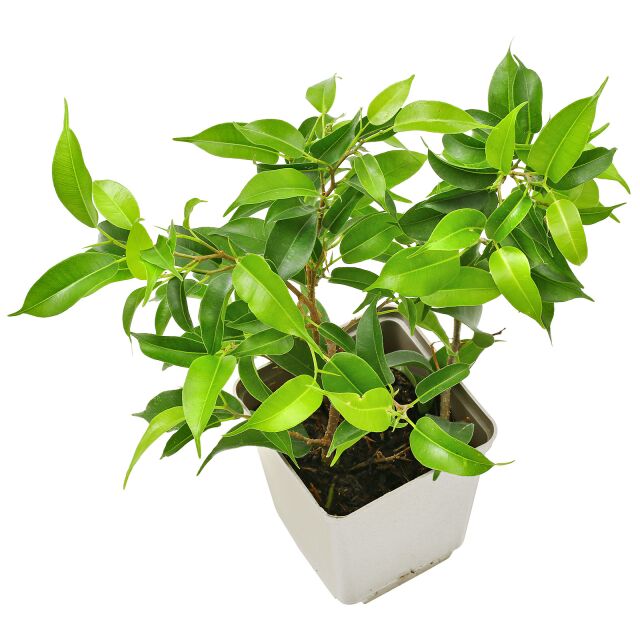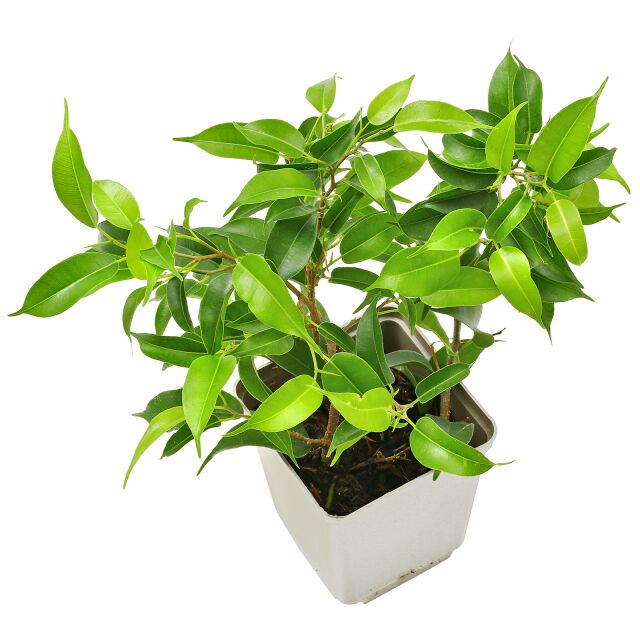Weeping fig



Ficus benjamina
Weeping fig
- Robust tropical woody plant
- Hanging branches and leaves
- Versatile
Item question
We’re here for you!
Please enter your question and e-mail and we’ll contact you as soon as possible. It usually takes us up to 24 hours during business days to respond.
Thank you for your question!
Thank you, we’ll get in touch!
Close window
You already sent us a question.
Please wait a few minutes
Description
Ficus benjamina or Weeping fig, an evergreen tree from tropical Asia, is justifiably popular as an indoor plant. In addition to its elegant appearance, it is extremely easy to care for. It is named after its drooping branches and leaves, somewhat similar to those of the silver birch (Betula pendula), therefore its German name "Birkenfeige" ("birch fig"). The medium to dark green, smooth leaves are extended into a "Drip tip", like those of many tropical trees. In contrast to the dark foliage, the trunk and branches have a light brown bark. Like many Ficus species, the Weeping fig can grow to a height of about 30 metres, but as an indoor and terrarium plant it does not grow rapidly in height. The growth can be limited by pruning; Ficus benjamina can also be grown as a bonsai.
"Benjamini", as the Weeping fig is also called, grows in any well-drained soil. This should be kept freshly to moderately moist and may become a little dry at times, but should neither dry out completely nor become waterlogged. This ficus will respond to rough care mistakes by dropping its leaves. When it has grown in well, it can be given a houseplant fertiliser. The light requirement is not high, but the growth is best in a bright position. Intensive lighting or sun is also tolerated. The temperature range is about 18 to 29 °C.
Ficus benjamina is an ideal, robust terrarium plant. It is easy to shape by pruning, can be grown as a shrub or tree and suits both terrarium types that take tropical dry or monsoon forests as their model and rainforest terrariums.
Profile
| Ficus benjamina | |
| Cultivation Options | Terrestrial, freestanding |
| Growth Height | Up to 2 - 3 m indoors, rarely taller |
| Temperature | 18 - 29 °C, not below 15 °C |
| Humidity | Moderate to high, regular misting recommended |
| Light Requirement | Bright, indirect light; avoid direct sunlight |
| Watering | Regular, avoid waterlogging; allow soil surface to dry off between waterings |
| Fertilization | Every 2 weeks with houseplant fertilizer during spring and summer |
| Propagation | Cuttings, air layering |
| Suitable for | Medium to large terrariums, offers hiding and climbing opportunities |
| Cultivation Options |
| Terrestrial, freestanding |
| Growth Height |
| Up to 2 - 3 m indoors, rarely taller |
| Temperature |
| 18 - 29 °C, not below 15 °C |
| Humidity |
| Moderate to high, regular misting recommended |
| Light Requirement |
| Bright, indirect light; avoid direct sunlight |
| Watering |
| Regular, avoid waterlogging; allow soil surface to dry off between waterings |
| Fertilization |
| Every 2 weeks with houseplant fertilizer during spring and summer |
| Propagation |
| Cuttings, air layering |
| Suitable for |
| Medium to large terrariums, offers hiding and climbing opportunities |
Terrarienpflanzen
Our terrarium plants give every terrarium an individual, natural atmosphere and at the same time provide a healthy environment for all terrarium inhabitants. Our wide range of tropical, subtropical and even arid plants are easy to combine and enhance any terrascape. Whether it's strong succulents, subtle tillandsias, eye-catching neoregelias or wonderful orchids - we offer terrarium plants for different terrascapes from rainforest to desert.
General information
Please choose a variant to see more information.
| Item no. |
|
| EAN | |
| Weight | |
| Shipping weight |
Customers ask customers
You have questions about this product? Ask other customer or our support team about this product!